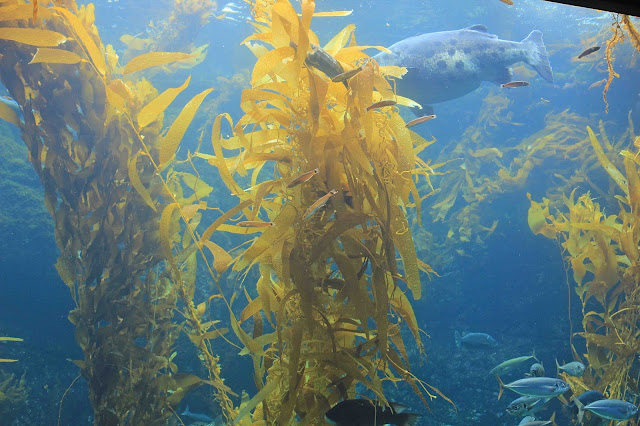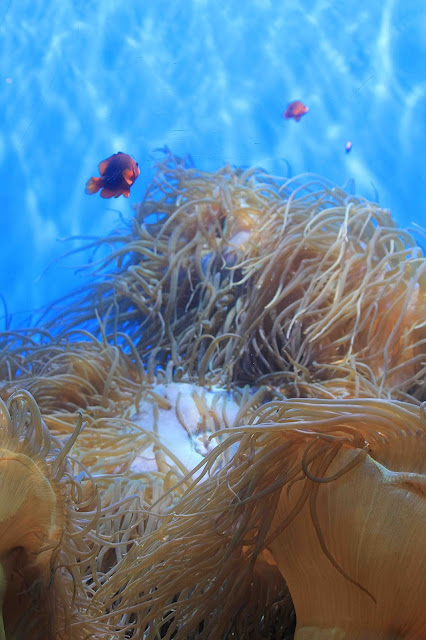San Diego is a relatively short distance from Murrieta and hence a great place for us to explore on our weeklong summer staycation this week. First stop, the Birch Aquarium in La Jolla. The reviews on Yelp and TripAdvisor were mostly very positive, but there were a few gripers complaining that the price of admission ($17 for adults) is too high, that it takes the average person only 1-2 hours to go through all the exhibits (i.e., there's not much to see), and there are no penguins and/or sea otters a la the Long Beach or Monterey Bay Aquariums. WELL! I must beg to differ. Sure, there are no cute feathery or furry critters on display, but that does not detract from the quality of the exhibits and the fundamental purpose of this facility, which is research and education. Besides, isn't this an aquarium and not a zoo? So if all they have are fish, marine invertebrates, shellfish and the like, doesn't that fit the bill? As for the price of admission, it's all for a good cause. And, to top it off, you can't beat the view of the Pacific Ocean from the Tide Pool Plaza.
In a nutshell, we had fun here and it was good to get away from the near triple digit summer heat at home (La Jolla was overcast, lightly breezy and a cool 71F at 10:30am). Word of warning, there are lots of visitors during the summer months because everyone seems to be on vacation during this time: locals, out-of-towners, foreigners, many with kids galore who apparently go bonkers when they see all those fish, sharks, rays & other cool stuff behind a tank. So, go early & take it all in stride when you are bombarded by the sounds of incessant chatter, boisterous squeals of delight and the occasional tantrum from the young'uns, cuz we were all kids once, too.
Here are the highlights:
Tide pool at the Preuss Tide Pool Plaza.
Tide pool at the Preuss Tide Pool Plaza.
Preuss Plaza.
ElasmoBeach exhibit.
ElasmoBeach exhibit.
Leopard shark, stingray, and the ghostly specter of Gil.
So, who's freakin' who out here?
ElasmoBeach exhibit.
Leopard sharks. Erasmo Beach exhibit.
Aquarium entry.
'The Legacy.' Life-sized gray whale fountain sculptures.
1966 Star III submersible on display at the entry to the parking area.
Smargon Court.
Smargon Court.
Solar-powered trash bins.
View of La Jolla and the Pacific Ocean from Preuss Plaza.
View of Ellen Browning Scripps Memorial Pier from Preuss Plaza.
In a nutshell, we had fun here and it was good to get away from the near triple digit summer heat at home (La Jolla was overcast, lightly breezy and a cool 71F at 10:30am). Word of warning, there are lots of visitors during the summer months because everyone seems to be on vacation during this time: locals, out-of-towners, foreigners, many with kids galore who apparently go bonkers when they see all those fish, sharks, rays & other cool stuff behind a tank. So, go early & take it all in stride when you are bombarded by the sounds of incessant chatter, boisterous squeals of delight and the occasional tantrum from the young'uns, cuz we were all kids once, too.
Here are the highlights:
8/20/13 Jack Mackerels (Trachunus symmetricus) in the Kelp Forest.
Giant Sea Bass (Stereolepis gigas) in the Kelp Forest. The giant sea bass can live up to 75
years and weigh over 500 lbs. No longer legal to be fished in California.
Garibaldi (Hypsypops rubicundus). In the Damselfish family. From Monterey to Baja
California (locally common in La Jolla Cove). This is the State fish of California.
Perches from San Diego Bay.
years and weigh over 500 lbs. No longer legal to be fished in California.
Garibaldi (Hypsypops rubicundus). In the Damselfish family. From Monterey to Baja
California (locally common in La Jolla Cove). This is the State fish of California.
Perches from San Diego Bay.
A tiny, tiny Lagoon Jelly (Mastigias papua). An Indo-Pacific species found in saltwater
lakes and bays that feeds on zooplankton. Has a symbiotic relationship with an algae called
zooxanthellae which produces sugars as a food product through photosynthesis.
lakes and bays that feeds on zooplankton. Has a symbiotic relationship with an algae called
zooxanthellae which produces sugars as a food product through photosynthesis.
Leafy Seadragon (Phycodurus eques). Endemic to the South coast of Australia.
Leafy Seadragons (Phycodurus eques).
Moon Jellies (Aurelia aurita). Found in temperate waters worldwide.
They feed on zooplankton and are harmless to humans.
They feed on zooplankton and are harmless to humans.
Moon Jellies (Aurelia aurita).
Moon Jellies (Aurelia aurita).
Sea Nettles (Chrysaora fuscescens). This jelly has a widespread range
(and a ton of stinging nematocysts with which to paralyze their prey).
(and a ton of stinging nematocysts with which to paralyze their prey).
Giant Black Jellyfish (Chrysaora achylos). Monterey to Baja California. The bell is a
distinctive dark purple-black in color. They can get really big (up to 3 feet in diameter, and
25 feet in length). Feeds on zooplankton and other jellyfish.
distinctive dark purple-black in color. They can get really big (up to 3 feet in diameter, and
25 feet in length). Feeds on zooplankton and other jellyfish.
Shrimpfish (Aeoliscus strigatus). From shallow tropical waters of the Indo-Pacific. Rather
unusual in that they swim with their heads pointing downwards. Go figure.
unusual in that they swim with their heads pointing downwards. Go figure.
Spotted Seahorses (Hippocampus kuda).
They look positively blue...from the Indo-Pacific West.
They look positively blue...from the Indo-Pacific West.
Dwarf Seahorses (Hippocampus zosterae).
The smallest species at 1". Western Atlantic: Florida Keys, Bahamas, Bermuda, Gulf of Mexico.
The smallest species at 1". Western Atlantic: Florida Keys, Bahamas, Bermuda, Gulf of Mexico.
Upside-Down Jelly (Cassiopea sp.).
From tropical lagoons in the Indo-Pacific. As their name suggests, they tend to hang out upside-down.
From tropical lagoons in the Indo-Pacific. As their name suggests, they tend to hang out upside-down.
Weedy Seadragons (Phyllopteryx toeniolatus). Endemic to the South coast of Australia to Tasmania.
I really think they should audition for Cirque du Soleil!
I really think they should audition for Cirque du Soleil!
Long-Snout Seahorse (Hippocampus reidi).
Western Atlantic: Florida to West Indies.
Western Atlantic: Florida to West Indies.
Pot-Bellied Seahorse (Hippocampus abdominalis).
Endemic to Southern Australia, Tasmania and New Zealand.
Endemic to Southern Australia, Tasmania and New Zealand.
Double-Ended Pipefish (Syngnathoides biaculeatus). Widespread in the tropical
Indo-West Pacific Ocean, E. Africa to the central Pacific islands. Cousins to seahorses.
Indo-West Pacific Ocean, E. Africa to the central Pacific islands. Cousins to seahorses.
Seahorse Nursery.
I'm embarrassed to admit it, but when I was a kid, I remember we had this ginormous jar
of chinese herbs soaking in booze with a few hapless seahorses gratuitously floating around in the
concoction. My sis and I used to stare at them in horrified fascination wondering, whyfor?
I'm sure it wasn't meant for children's consumption, because my mom never ordered us to
drink the stuff as she would have with a number of other Chinese herbal elixirs that were
supposed to be good for us. Anyways, thank the deuces Mom gave up on and/or lost
interest in most of these exotic libations years ago.
Strawberry Anemone (Corynactis california). NW coast.
Beaded Anemone (Urocina lofotensis). WA to Southern California, Atlantic Ocean.
White spots on red body give it the name.
California King Crab (Paralithodes californiensis).
This one's more 'wee prince' than 'king.'
Fragile Urchin (Arlocentrotus fragilis).
Orange Triggerfish (Sufflamen verres).
Pacific coast of Central & South America (Mexico to Ecuador).
Giant Hawkfish (Cirrhitus rivulets).
From submarine canyon in Cabo San Lucas, Mexico. Ranges from Gulf of California to Galapagos.
Moorish Idol (Zanclus cornutus). Tropical Pacific.
Scrawled Filefish (Alubrus scriptus). Tropical reefs.
Yellow Tang (Zebrasoma flavescens). Tropical lagoons.
Banggai Cardinalfish (Pteropogon kanderni). Banggai Islands of Indonesia.
Pacific Spadefish (Chaetodipterus zonatus). E. Pacific from San Diego to Peru.
Sardine tank at the entrance to the Hall of Fishes.
of chinese herbs soaking in booze with a few hapless seahorses gratuitously floating around in the
concoction. My sis and I used to stare at them in horrified fascination wondering, whyfor?
I'm sure it wasn't meant for children's consumption, because my mom never ordered us to
drink the stuff as she would have with a number of other Chinese herbal elixirs that were
supposed to be good for us. Anyways, thank the deuces Mom gave up on and/or lost
interest in most of these exotic libations years ago.
Beaded Anemone (Urocina lofotensis). WA to Southern California, Atlantic Ocean.
White spots on red body give it the name.
California King Crab (Paralithodes californiensis).
This one's more 'wee prince' than 'king.'
Fragile Urchin (Arlocentrotus fragilis).
Orange Triggerfish (Sufflamen verres).
Pacific coast of Central & South America (Mexico to Ecuador).
Giant Hawkfish (Cirrhitus rivulets).
From submarine canyon in Cabo San Lucas, Mexico. Ranges from Gulf of California to Galapagos.
Moorish Idol (Zanclus cornutus). Tropical Pacific.
Scrawled Filefish (Alubrus scriptus). Tropical reefs.
Yellow Tang (Zebrasoma flavescens). Tropical lagoons.
Banggai Cardinalfish (Pteropogon kanderni). Banggai Islands of Indonesia.
Pacific Spadefish (Chaetodipterus zonatus). E. Pacific from San Diego to Peru.
Sardine tank at the entrance to the Hall of Fishes.
Assorted Western Pacific reef fish.
Western Pacific reef fish.
Red Saddleback Anemonefish (Amphiprion ephippium).
Red Saddleback Anemonefish (Amphiprion ephippium).
Queen Angelfish (Holocanthus ciliarus). Lagoons of tropical seas.
Round Stingray (Urobatis halleri). San Diego Bay.
California moray eels (Gymnothoraz mordax). Kinda dark, but they still look gnarly.
Wolf eel (Anarrhicthys ocellatus).
OMG, that is one fugly, upside-down eel! Anyhoo...their gnarly jaws & teeth allow them to
imbibe on the hard-shelled stuff like sea urchins and crabs. They occur from Kodiak Alaska
all the way down to San Diego (albeit in colder, deeper waters here in SoCal).
Western Pacific reef fish.
Red Saddleback Anemonefish (Amphiprion ephippium).
Red Saddleback Anemonefish (Amphiprion ephippium).
Queen Angelfish (Holocanthus ciliarus). Lagoons of tropical seas.
Round Stingray (Urobatis halleri). San Diego Bay.
California moray eels (Gymnothoraz mordax). Kinda dark, but they still look gnarly.
Wolf eel (Anarrhicthys ocellatus).
OMG, that is one fugly, upside-down eel! Anyhoo...their gnarly jaws & teeth allow them to
imbibe on the hard-shelled stuff like sea urchins and crabs. They occur from Kodiak Alaska
all the way down to San Diego (albeit in colder, deeper waters here in SoCal).
Golden Jack (Gnathanodon specious). Indo-Pacific.
Roots in sandy bottoms for invertebrates and small fish.
Roots in sandy bottoms for invertebrates and small fish.
Tide pool at the Preuss Tide Pool Plaza.
Tide pool at the Preuss Tide Pool Plaza.
Preuss Plaza.
ElasmoBeach exhibit.
ElasmoBeach exhibit.
Leopard shark, stingray, and the ghostly specter of Gil.
So, who's freakin' who out here?
ElasmoBeach exhibit.
Leopard sharks. Erasmo Beach exhibit.
Aquarium entry.
'The Legacy.' Life-sized gray whale fountain sculptures.
1966 Star III submersible on display at the entry to the parking area.
Smargon Court.
Smargon Court.
Solar-powered trash bins.
View of La Jolla and the Pacific Ocean from Preuss Plaza.
View of Ellen Browning Scripps Memorial Pier from Preuss Plaza.
INFO:
Location: 2300 Expedition Way, La Jolla, CA 92037
County/State: San Diego, CA
Website: http://aquarium.ucsd.edu
Amenities: Gift shop, restrooms, cafe, tours, programs
Hours: 9am - 5pm daily
Fees:
Adult: $17
Teen (13-17): $14
Child (3-12): $12.50
Senior (60+): $13
UCSD student/staff w/ID: $11
College Student w/ID: $12
Ages 2 and under: Free
Teen (13-17): $14
Child (3-12): $12.50
Senior (60+): $13
UCSD student/staff w/ID: $11
College Student w/ID: $12
Ages 2 and under: Free
_Kelp+Forest_Birch+Aquarium_8.20.13.jpg)



_Birch+Aquarium_8.20.13.jpg)
_Birch+Aquarium_8.20.13.jpg)
_Birch+Aquarium_8.20.13.jpg)
_Birch+Aquarium_8.20.13.jpg)

_Birch+Aquarium_8.20.13.jpg)
_Birch+Aquarium_8.20.13.jpg)

_Birch+Aquarium_8.20.13.jpg)
_Birch+Aquarium_8.20.13.jpg)
_Birch+Aquarium_8.20.13.jpg)
_8.20.13.jpg)
_Birch+Aquarium_8.20.13.jpg)


























.jpg)
.jpg)

_Birch+Aquarium_8.20.13.jpg)






























Going to Aquariums feels like you are underwater together with the other marine animals.Seeing such natural creature makes you feel so glad and you can take out your children there for having fun with them also.
ReplyDelete